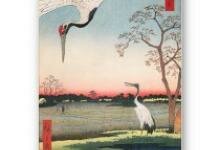Beauty in Brevity
Singapore’s famous poet and playwright tells us why he admires the tanka, an ancient form of Japanese poetry.

I am writing about the tanka as an enthusiastic student, and admirer of it, and not as a scholar.
It is an ancient form of Japanese poetry that goes back to the seventh century and its influence persists well into the modern period which may be said to begin in 1868, when Japan absorbed Western influences.
The Form
It is best to begin with the form as that is what makes the tanka unique. Without going too much into complex technical details, the tanka consists of 5 lines, the first and third have 5 and the rest 7 syllables.
Iwashiro no (5) On the beach of Iwashiro,
Hamamatsu go e wo (7) I pull and knot together
Hikimusubi (5) The branches of the pine.
Masakiku araba (7) If my fate turns out well,
Mata kaerimimu (7) I shall return to see them again.
This tanka is about Prince Arima preparing for a journey.
In translation, the number of syllables in Japanese will not equal the same number, line by line, in English. The best that the translator can do is to capture the essence of the original poem without sacrificing accuracy.
Technique
The brevity of the form forces the poet to compress and he (I will use “he” for convenience) does this by suggestion and allusion. Figures of speech like metaphors and symbols referring to Nature like flowers, birds and clouds as examples, or to the seasons, or to religion (the Shinto or Buddhist religions ) enable the tanka poet to tap associations known to both. The poet only needs to imply, often indirectly, and his readers will know becuse they have shared meanings.
Some Western critics of the tanka have pointed out that the traditional Japanese poet did not have an appetite for long poems and so the 5-lines, 31-syllables form suited them like a glove. There is truth in this statement but note how the poets have made a virtue out of necessity.
Themes
The tanka poet deals with what is best described as inter-connected universal themes: love between men and women, love for Nature, travel, transience, desire (linked to Buddhist thought) and so on. Here are examples:
A love poem by Yakamochi:

By way of pretext
I said ' I will go
And look at
The condition of the bamboo fence;
But it was really to see you!
Note the modesty of the tone and the reference to bamboo.
The tanka poet prefers to understate and this affects his tone. In English, the male sometimes refers to his female lover as Sister, and she, in turn addresses him as My Lord. This seems quaint today but it does convey the sense of decorum.
This is a Nature-filled tanka by Onakatomi Yoshinobu. Note the allusion to deer, montains and autumn.
The deer which lives
On the evergreen mountains
Where there are no autumn leaves
Can know the ( coming of ) autumn
( Only ) by its own cry.
This is a poem about change, about time passing, about transience by Ariwara Narihira.

Can it be that the moon has changed?
Can it be that spring
Is not the spring of old times? Is it my body alone
That is just the same?
An Analysis
To illustrate the features of the tanka, try to analyse this one.
In this world
If there were no
Ox-cart
How should we escape
From the burning mansion of our thoughts?
Here are come clues. One, it is a reference to a famous parable in the Saddharma Pandariks Sutra. Some children were in a burning house. Intent on their play they could not be induced to leave the building, till their father lured them out by the promise that they would find toy-carts. Two, the burning house is a reference to the carnal life.
What do you think the poem is about?
[I am indebted to two sources for this article, The Penguin Book of Japanese Verse, translated and with an introduction by Geoffrey Bownas and Anthony Thwaite, and Arthur Waley, Japanese Poetry The ‘The Uta’ ]
Robert Yeo is a Singapore poet, playwright and novelist. He has published four poetry collections, a novel and six plays. Now 70, Yeo is currently working on his autobiography, Routes 1940-1975.
Yeo is also a founder of OperaViva, and has written the libretto for Singapore’s second-ever full-length opera, Fences. The composer is John Sharpley.
Images from www.zazzle.com and www.fitzmuseum.cam.ac.uk.

















